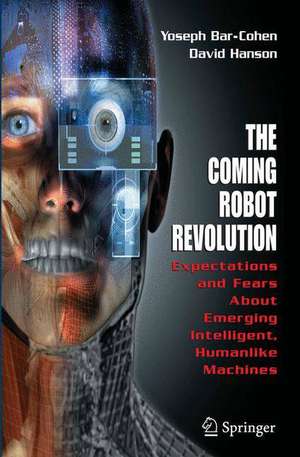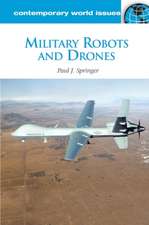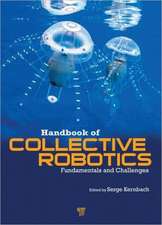The Coming Robot Revolution: Expectations and Fears About Emerging Intelligent, Humanlike Machines
Autor Yoseph Bar-Cohen Design de Adi Marom Autor David Hansonen Limba Engleză Hardback – 27 feb 2009
| Toate formatele și edițiile | Preț | Express |
|---|---|---|
| Paperback (1) | 154.62 lei 3-5 săpt. | |
| Springer – 23 aug 2016 | 154.62 lei 3-5 săpt. | |
| Hardback (1) | 214.22 lei 3-5 săpt. | |
| Springer – 27 feb 2009 | 214.22 lei 3-5 săpt. |
Preț: 214.22 lei
Nou
Puncte Express: 321
Preț estimativ în valută:
40.100€ • 44.52$ • 34.44£
40.100€ • 44.52$ • 34.44£
Carte disponibilă
Livrare economică 01-15 aprilie
Preluare comenzi: 021 569.72.76
Specificații
ISBN-13: 9780387853482
ISBN-10: 0387853480
Pagini: 173
Ilustrații: XII, 173 p.
Dimensiuni: 155 x 235 x 13 mm
Greutate: 0.45 kg
Ediția:2009
Editura: Springer
Colecția Springer
Locul publicării:New York, NY, United States
ISBN-10: 0387853480
Pagini: 173
Ilustrații: XII, 173 p.
Dimensiuni: 155 x 235 x 13 mm
Greutate: 0.45 kg
Ediția:2009
Editura: Springer
Colecția Springer
Locul publicării:New York, NY, United States
Public țintă
Popular/generalCuprins
Emerging Humanoids and Humanlike Robots.- How to Make a Humanlike Robot.- Prosthetics, Exoskeletons, and Bipedal Ambulators.- Mirroring Humans.- Trends in Robotics.- Ethical Issues and Concerns–Are they going to continue to be with us or will they turn against us?.- A Whole New World.
Recenzii
From the reviews:“The text is written as a progressive narrative on the impact of humanlike robots becoming more common within our society and the ethical ramifications of those robots. … it is accessible to a wide audience of individuals that have a background in robotics, artificial intelligence, etc. … useful in a graduate-level course such as a course on human-robot interaction (HRI). Summing Up: Recommended. Upper-division undergraduates through researchers/professionals.” (R. S. Stansbury, Choice, Vol. 47 (3), November, 2009)
Notă biografică
Dr. Yoseph Bar-Cohen is a Senior Scientist and Group Supervisor at the Jet Propulsion Lab [http://ndeaa.jpl.nasa.gov/], NASA/Caltech, specializing in electroactive materials and devices as well as biomimetic mechanisms. Famous for his pivotal role in artificial muscles, many news articles describe him as the "artificial muscle" man and per Business week he is one of five technology gurus who are "Pushing Tech's Boundaries". Dr. Bar-Cohen received his Ph. D. in physics (1979) from the Hebrew University, Jerusalem, Israel. Some of his notable discoveries include the leaky Lamb waves (LLW) and polar backscattering (PBS) phenomena in composite materials. He (co)authored over 300 publications, made numerous presentations at national and international conferences, (co)chaired 37 conferences, has 19-registered patents and he is the (co)editor of 4 books with the topics that include artificial muscles, biologically inspired robots and biomimetics. He is the initiator of the SPIE Conf. on electroactive polymers (EAP), chairing it since 1999. He challenged wrestling match between an arm driven by EAP and human and held contents in 2005 and 2006. Dr. Bar-Cohen’s research and accomplishments with his teams received extensive media coverage including journals, magazines, radio and TV interviews as well as internet coverage in many thousands of websites [http://ndeaa.jpl.nasa.gov/nasa-nde/nde-aa-l/newsclipping.htm]. His scientific, engineering and technology accomplishments have earned him Fellow of the American Society for Nondestructive Testing (ASNT), since 1996, and The International Society for Optical Engineering (SPIE), since 2002. Also, he is the recipient of two NASA Honor Award Medals - NASA Exceptional Engineering Achievement Medal (2001), and NASA Exceptional Technology Achievement (2006), two SPIE’s Lifetime Achievement Awards – NDE (2001) and Smart Materials and Structures (2005), the 2006 ASNT Sustained Excellence award the 2007 SPIE President’s Award aswell as many other honors and awards. Further information is available at http://ndeaa.jpl.nasa.gov/nasa-nde/yosi/yosi.htm
Dr. David Hanson is the founder and Chairman/CEO of Hanson Robotics. He is an Artist/scientist who creates realistic humanoid robots (a.k.a. androids), which are noted for being conversationally intelligent, energy efficient, and designed as novel works of character art/animation. In 2005, the low-power mobility of Hanson's robots was demonstrated within the world's first expressive walking humanoid, an Einstein portrait called "Albert Hubo," appearing on the cover of WIRED magazine, Jan. 2006. Hanson’s patented Frubber (Flesh-rubber) material makes this low-power mobility possible. In addition to hardware innovations, Hanson and his company (Hanson Robotics Inc., http://www.hansonrobotics.com/) are known for developing increasingly intelligent conversational personas, integrating many forms of artificial intelligence (AI) including speech recognition software, natural language processing, computer vision, and Hanson's own AI systems to hold naturalistic conversations. In 2005 Hanson and his team received an AAAI award for the intelligent conversational portrait of Philip K Dick [AI Magazine, fall 2005]. By simulating the integrated conversational human, such robots enable design studies of general intelligence in machines, paving a continuum toward true machine sentience over coming years. Hanson's robots have been extensively covered in the news media, including in the NY Times, Ubiquity, WIRED, Popular Mechanics, the Science Channel, Popular Science, the Discovery Channel, and many other media venues. Hanson has received awards in both art and engineering, including Cooper Hewwit Triennial award, National Science Foundation STTR award, and a TX Emerging Technologies Award. Hanson received a BFA from Rhode Island School of Design in 1996, and his PhD from the University of Texas at Dallas in 2007.
GRAPHICARTIST BIO
Ms. Adi Marom is a designer/artist with a Masters of Design Engineering from The University of Tokyo, Japan (2005) and a BA Design from Bezalel Academy of Arts and Design, Jerusalem, Israel (1999). Her work experience includes working at the New York based Hoberman Associates - Transformable Design studio; the Tokyo based studio Landscape Products; as well as the Tel-Aviv based Studio de Lange. Ms. Marom’s multidisciplinary practice includes graphic and product design. In this creative framework, she specialized in the design of innovative kinetic products based on folding mechanisms. Ms. Marom’s Masters studies focused on the field of Biomimetics and addressed the challenge of applying natural deployable structures into man made objects. For instance, she applied the mechanical properties of carnivorous plants’ traps in the design of artificial autonomous pets - sustainable by trapping organic substrates. Ms. Marom’s designs have been featured in tradeshows and exhibitions around the world, garnering her international awards and media publications. Her designs have been exhibited at Milan's international furniture show "Salone International Del Mobile" (Italy 2001); the traveling exhibition "Domains - Contemporary Israeli Design Exhibition" (Japan, China, Korea, Taiwan and Australia 2002-2004), and "The Tokyo International Gift Show" (Japan 2005). Her works have been featured in international magazines such as Casa Brutus (Japan 2002); Binyan Ve Diyur (Israel 2004); Joong Ang Daily (Korea 2003). In addition, her illustrations were featured in the book "Biomimetics: Biologically-Inspired Technologies" by Dr. Yoseph Bar-Cohen (Ed.), CRC Press, November 2005.
Dr. David Hanson is the founder and Chairman/CEO of Hanson Robotics. He is an Artist/scientist who creates realistic humanoid robots (a.k.a. androids), which are noted for being conversationally intelligent, energy efficient, and designed as novel works of character art/animation. In 2005, the low-power mobility of Hanson's robots was demonstrated within the world's first expressive walking humanoid, an Einstein portrait called "Albert Hubo," appearing on the cover of WIRED magazine, Jan. 2006. Hanson’s patented Frubber (Flesh-rubber) material makes this low-power mobility possible. In addition to hardware innovations, Hanson and his company (Hanson Robotics Inc., http://www.hansonrobotics.com/) are known for developing increasingly intelligent conversational personas, integrating many forms of artificial intelligence (AI) including speech recognition software, natural language processing, computer vision, and Hanson's own AI systems to hold naturalistic conversations. In 2005 Hanson and his team received an AAAI award for the intelligent conversational portrait of Philip K Dick [AI Magazine, fall 2005]. By simulating the integrated conversational human, such robots enable design studies of general intelligence in machines, paving a continuum toward true machine sentience over coming years. Hanson's robots have been extensively covered in the news media, including in the NY Times, Ubiquity, WIRED, Popular Mechanics, the Science Channel, Popular Science, the Discovery Channel, and many other media venues. Hanson has received awards in both art and engineering, including Cooper Hewwit Triennial award, National Science Foundation STTR award, and a TX Emerging Technologies Award. Hanson received a BFA from Rhode Island School of Design in 1996, and his PhD from the University of Texas at Dallas in 2007.
GRAPHICARTIST BIO
Ms. Adi Marom is a designer/artist with a Masters of Design Engineering from The University of Tokyo, Japan (2005) and a BA Design from Bezalel Academy of Arts and Design, Jerusalem, Israel (1999). Her work experience includes working at the New York based Hoberman Associates - Transformable Design studio; the Tokyo based studio Landscape Products; as well as the Tel-Aviv based Studio de Lange. Ms. Marom’s multidisciplinary practice includes graphic and product design. In this creative framework, she specialized in the design of innovative kinetic products based on folding mechanisms. Ms. Marom’s Masters studies focused on the field of Biomimetics and addressed the challenge of applying natural deployable structures into man made objects. For instance, she applied the mechanical properties of carnivorous plants’ traps in the design of artificial autonomous pets - sustainable by trapping organic substrates. Ms. Marom’s designs have been featured in tradeshows and exhibitions around the world, garnering her international awards and media publications. Her designs have been exhibited at Milan's international furniture show "Salone International Del Mobile" (Italy 2001); the traveling exhibition "Domains - Contemporary Israeli Design Exhibition" (Japan, China, Korea, Taiwan and Australia 2002-2004), and "The Tokyo International Gift Show" (Japan 2005). Her works have been featured in international magazines such as Casa Brutus (Japan 2002); Binyan Ve Diyur (Israel 2004); Joong Ang Daily (Korea 2003). In addition, her illustrations were featured in the book "Biomimetics: Biologically-Inspired Technologies" by Dr. Yoseph Bar-Cohen (Ed.), CRC Press, November 2005.
Textul de pe ultima copertă
There have been huge advances in robot technology in the last few years. More and more "humanlike" robots are being developed in labs for a wide variety of medical, manufacturing, and commercial uses. These "smart" people lookalikes are being designed to help with household chores, as office workers, to perform tasks in space and in other dangerous environments, and to assist in schools and hospitals. Humanlike robots, in other words, are coming, and they may fundamentally change the way we live, even the way we view ourselves.
Will robots that look and act a lot like us be a threat to us? Or will they blend into our culture and eventually even be considered peers? Will they have feelings along with their artificial skin and metal bones? Will they act ethically? Are we taking sufficient care to make sure that they do?
These questions and many more are posed by the authors of this important book, which demands that we take steps now to insure that the technology doesn’t lead us into potentially dangerous scenarios with a "species" we have created. What laws will be needed to keep things under control? Should robots be allowed to store private and personal information in their circuits or be given freedom to act on their own? Do we want robots as teachers, police officers, doctors, and accountants, or do we want them to only do menial tasks? Will there be "renegade" robots that set out to harm people? Will robot soldiers increase the chance of war?
There are no easy answers to these questions. But the time to look for answers is now.
Will robots that look and act a lot like us be a threat to us? Or will they blend into our culture and eventually even be considered peers? Will they have feelings along with their artificial skin and metal bones? Will they act ethically? Are we taking sufficient care to make sure that they do?
These questions and many more are posed by the authors of this important book, which demands that we take steps now to insure that the technology doesn’t lead us into potentially dangerous scenarios with a "species" we have created. What laws will be needed to keep things under control? Should robots be allowed to store private and personal information in their circuits or be given freedom to act on their own? Do we want robots as teachers, police officers, doctors, and accountants, or do we want them to only do menial tasks? Will there be "renegade" robots that set out to harm people? Will robot soldiers increase the chance of war?
There are no easy answers to these questions. But the time to look for answers is now.
Caracteristici
Portrays both the allure of today’s humanlike robots and the future implications creating a past-present-future timeline Includes state of the art photos and futuristic illustrations Includes illustrations that portray the trends in robotics that is exponentially increasing in capabilities resulting from advances in computer hardware, intelligent software, and deepening the understanding of human mind and body Addresses possible nightmare scenarios associated with the future of this technology and the efforts to prevent them Includes supplementary material: sn.pub/extras












